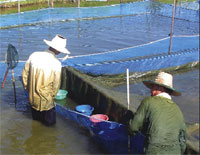Aquaculture of Indigenous Mekong Species
 Freshwater
ecosystems are among the world's most degraded habitats. Research
shows that their biodiversity has halved since 1970. Invasive
alien species (IAS) are the second most important cause of falling
biodiversity after habitat loss. Alien species may reduce native
biodiversity through competition, predation and the introduction
of disease.
Freshwater
ecosystems are among the world's most degraded habitats. Research
shows that their biodiversity has halved since 1970. Invasive
alien species (IAS) are the second most important cause of falling
biodiversity after habitat loss. Alien species may reduce native
biodiversity through competition, predation and the introduction
of disease.
Although under increasing pressure, the environment of the Mekong basin is still relatively healthy. However, aquaculture in the basin commonly uses alien species. Some of these have escaped from farms, colonised parts of the basin, and displaced native fish species.
AIMS endeavours to support environmental management in the basin by developing aquaculture techniques for indigenous fish species. Successful aquaculture will lower the demand for exotic species in fish farming and reduce the need to introduce alien species. AIMS supports a network of counterparts working in fisheries line agencies in the four riparian countries and is involved in research and development activities at 11 aquaculture stations across the region. In addition, AIMS is engaged in the development of regional codes of practice to achieve more control over movement of both alien and indigenous species.
The main studies undertaken during the last year were:
Domestication of Cirrhinus microlepis: Joint research effort by the four riparian countries has enhanced the aquaculture techniques used on this popular species. Success rates are now closer to the levels required to make commercial cultivation feasible. In the past year, stations in Lao PDR, Thailand and Viet Nam successfully induced spawning of brood stock. Furthermore, Vietnamese stations successfully raised larvae obtained from captive brood stock.
Other priority species: The cooperating stations now have well developed techniques for inducing spawning in the remaining eight priority species and brood stock are widely available. The positive results over the past year were to a large degree a result of training in fish feed manufacture and feeding techniques during the previous year. Improved feed formulation, particularly for brood stock, and better systems for feed delivery contributed to higher egg and larvae quality, and thus better growth and survival of fry.
Fish stocking: During the year, AIMS, in cooperation with national fisheries agencies from the four riparian countries, stocked a number of lakes and reservoirs. In several cases, AIMS carried out stocking in cooperation with MRRF-supported fisheries management institutions. This is an important relationship, since the measurement of successful fisheries enhancement should reflect the benefits that accrue to the communities that live around the water body. Surveys show the presence of a local fisheries management institution greatly increases the likelihood of a positive outcome.
Mobile hatcheries: Increasing use was made of the mobile hatcheries that AIMS developed in previous years. This enables managers to produce seed using local brood fish to ensure it is genetically similar to the wild populations.
Fish biology and classification: This year the component in Viet Nam also worked on the classification of the indigenous fish species, Anabas testudineus, Channa spp. and Trichogaster pectoralis. Local populations of these species may live in the Mekong Delta. Defining the distribution and occurrence of naturally occurring populations is a first step in reducing the risk of adverse affects on biodiversity caused by movement of non-indigenous or domesticated types.
Work on the nine priority species will continue in the coming year. However, as the optimum culture and artificial reproduction techniques for most of these species are now well understood and applied, the focus of the component's work will shift towards developing on-farm grow-out and on-farm hatcheries.
The coming year will see the implementation of more than 50 sub-activities, including on-station and on-farm research as well as workshops. The component also plans to hold additional training covering project management, technical and other issues. There will also be national and regional study tours.
Choose a newsletter: